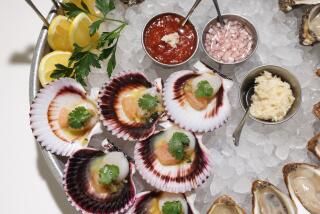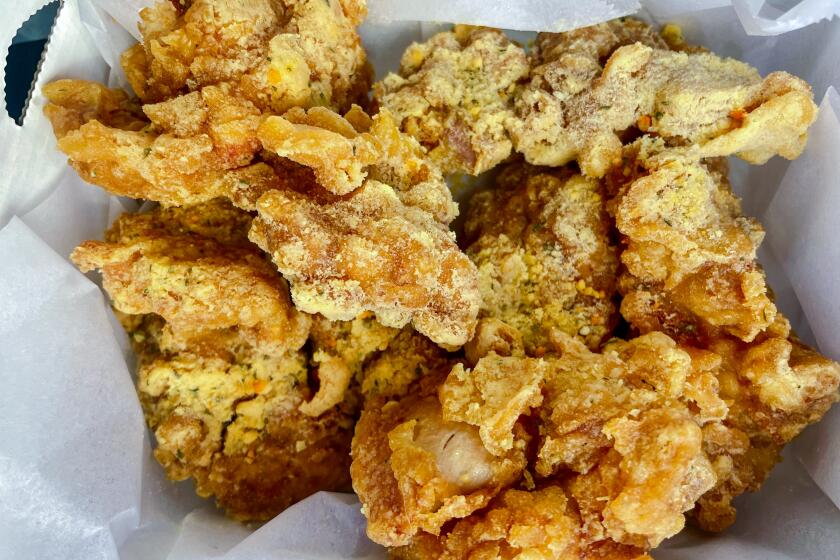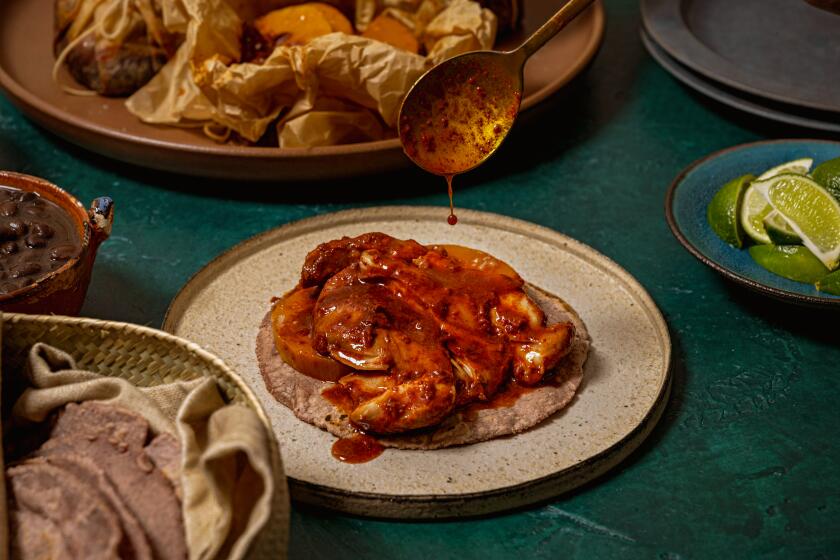NOODLES FROM THE EAST : Golden rice sticks, above, are one of the Oriental noodles available to Los Angeles shoppers looking for ways to make meals such as the Vietnamese soup, below.
It may be too soon to call the popularization of Oriental noodles a craze, but we’re getting close.
You’ll notice more noodle shops around town than ever before. Ramen houses (featuring Japanese renditions of Chinese noodle soup) appear in neighborhoods wherever Japanese dine, for ramen is to the Japanese what hamburgers are to Americans. Indeed, Americans are enjoying the ready-to-reconstitute dried ramen sold at most American supermarkets.
There are Japanese noodle stands, such as the one at Mifune in Little Tokyo, serving steaming bowls of udon , the fat pasty noodle, and soba, the firm buckwheat noodle, both of which Japanese consider snack food for breakfast, lunch or supper. Made of alimentary paste (usually flour and water), udon can be compared, with a stretch of the imagination, to long, hollow strands of Italian macaroni. Soba is much like whole-wheat spaghettini and can be used similarly.
The Japanese fascination with things Italian in recent years helped create Curry House, a worldwide specialty noodle house chain that features Japanese noodles with toppings no Italian would ever guess possible. Who has ever seen a poached egg sitting on a pile of sea-weeded spaghetti in Genoa? The noodles, manufactured locally as well as imported from Japan, are a close copy of Italian spaghetti. Most Japanese grocery stores carry a variety of noodles in fresh, frozen and dry forms.
Metropolis, a Japanese-Italian restaurant in West Hollywood, serves a perfectly round portion of squid-ink pasta--about the size of a tennis ball--in the center of a deep Japanese bowl. Chaya Brasserie in Los Angeles also specializes in Italian cuisine, but the results cannot escape the restaurant’s Oriental roots. Many of its pastas are served as cold salads and have a definitively Japanese appearance.
At Curry Club, a Japanese curry house on Melrose Avenue featuring rice, you’ll find a cold Italian pasta salad with a Japanese twist--it’s seasoned with soy sauce and miso.
Oriental noodles are being internationalized by American entrepreneurs as well. At Chin Chin, in West Hollywood, and its close clone Chopstix, in Los Angeles, both streamlined dim sum cafes with Anglo merchandising know-how, noodles are prepared by Oriental chefs but often are takeoffs, not strict interpretations, of Chinese noodle dishes. For instance, Crazy Coconut Noodles are tossed with coconut sauce, barbecued meat, chicken or shrimp at Chopstix. A crunchy lemon noodle salad is a concoction of noodles tossed with rice sticks, fried won-ton skins and raw vegetables.
At Chin Chin, an Oriental vermicelli noodle also used in chow mein dishes, is teamed with preserved Chinese radish and a peanut sauce made with chile oil and soy sauce for a dish that can be eaten hot or cold.
Other American cafes in the Los Angeles area, among them the Authentic Cafe, Stepps and Chez Melange, specialize in “crossover” foods--dishes that may be a blend of various cuisines. A menu at any of these restaurants is sure to include several Oriental noodle dishes requiring a paragraph or two of description. Otherwise, who could figure it all out just looking?
At Chez Melange, for instance, manager Robert Bell reports that some crossovers may team Japanese food with Southwestern ideas. An example is the Oriental sesame noodle salad given here.
Roger Hayot, owner of the Authentic Cafe, uses wasabi with Indonesian kecap manis, a sweet soy sauce seasoning considered a staple in the Indonesian saute repertoire, to create the chicken-noodle saute dish given here. The chicken is fried Chinese style with cornstarch coating then combined with shiitake mushrooms, peanuts, chiles and ginger.
Old-fashioned Cantonese chow mein and lo mein also are enjoying a revival. Appreciated for the pasta-perfect effect they have on health, dining satisfaction and budget gratification, these dishes should enjoy a long-lasting comeback.
Rice sticks, a loose term used for Chinese, Thai or Vietnamese noodles made with rice starch as well as to describe Oriental vermicelli noodles, sometimes are added to steaming soup with various toppings. They also can be served cold with peanut sauce or pan-fried and topped with vegetables, meat or fish. All are worth rediscovering for fast and easy meals to prepare on a busy day.
The rice sticks used in Southeast Asian cooking originated in China, where Marco Polo also was said to have been smitten with the fanciful noodle before introducing it to his Venetian patrons.
There are many varieties of vermicelli and rice sticks. It’s best to experiment with several kinds to find the type most appealing. Some rice sticks are sold dried in folded bundles, others long and spaghetti-like in various widths and lengths. Opaque white rice sticks used in Chinese chicken salad, for instance, expand to several times their original size when deep-fried. They brown rapidly, so must be watched carefully. They are removed from the cooking oil practically the instant they hit the hot fat.
Lacking Chinese vermicelli or spaghetti-like rice sticks, use Italian brand angel hair pasta or spaghettini for a similar effect. Cooking time is virtually the same as for Chinese vermicelli or rice sticks.
Unprecedented Oriental immigration to Los Angeles during the past decade and the resulting growth of Thai and other Southeast Asian restaurants locally have inspired a new taste for hot and spicy foods, particularly noodles.
The Times receives letters from children requesting recipes for pad Thai, the sauted spaghetti-like rice stick seasoned with chile oil and fish oil, and Thai mee krob, the crispy, honeyed, fried rice sticks that puff to several times their original size when fried. These are served as snacks or appetizers in restaurants. That’s how integrated they have become in our culinary setting. The pad Thai given here is a recipe from Tommy Tang’s Siamese Kitchen in Los Angeles.
Vietnamese noodle dishes are still relatively unknown to most diners, but they too are luring more and more aficionados to small mom and pop noodle houses for lunch or supper. Vietnamese, like other Asians, love to spike their rice noodles (rice sticks) with chile paste, oil or flakes for a hot bite. And if you order noodles as a soup at a local restaurant (Hanoi Soup is an example of a basic soup to which meat, fish or vegetables are added), you’ll probably be served fried bread hot off the stove.
Slippery, viscous cellophane noodles (known also as bean threads or silver noodles) are translucent with a silvery cast. They are made of mung beans and have a high protein content that gives them a tougher consistency than most Oriental noodles; they require soaking before cooking to soften them. Cellophane noodles are enjoyed throughout the Orient, particularly by Southeast Asians, who use them in soups and stir-fry dishes.
Here is a sampling of dishes from various sources to show the scope of Oriental noodles as used today. We also provide a brief glossary of various Oriental noodles and basic suggestions for cooking and serving them.
CHOPSTIX SHREDDED CHICKEN SALAD
3 cups cooked chicken meat, slivered
4 cups shredded Romaine
1 cup bean sprouts
2 cups shredded purple cabbage
1/2 cup red sweet ginger, thinly sliced
10 won ton skins
Oil for frying (about 3 cups)
2 ounces opaque rice sticks
Dressing
1/2 cup slivered almonds, toasted
Place chicken, Romaine, bean sprouts, cabbage and ginger in large bowl.
Cut won ton skins into 1/4-inch wide strips. Heat oil to 350 degrees and add won ton strips. Fry until light golden. Drain on paper towels.
Heat oil again until hot enough to cause rice sticks to expand moment they are added to oil. Cook rice sticks in small batches, until puffed. Drain on paper towels.
Add Dressing to chicken mixture in bowl and toss to mix well. Gently stir in won tons, rice sticks and almonds. Makes 12 appetizer or 6 to 8 dinner salad servings.
Dressing
1/4 cup red wine vinegar
1 tablespoon light soy sauce
2 tablespoons sesame oil
2 tablespoons juice from jar of red sweet ginger
1/2 teaspoon Chinese chile sauce
1/2 teaspoon salt
3 tablespoons minced green onion
1 tablespoon finely minced ginger root
Combine vinegar, soy sauce, oil, ginger, chile sauce, salt, green onion and ginger. Shake well before using.
CHOPSTIX PRIMAVERA
1/2 pound dry Oriental vermicelli or egg noodles (spaghetti-style) noodles, preferably Chinese
1 tablespoon vegetable oil
2 cups bean sprouts
1 sweet red pepper, slivered
2 cups match stick-cut carrots
2 green onions, shredded
2 cups broccoli florets
1 tablespoon cornstarch
1 tablespoon cold water
3 cloves garlic, finely minced
2 tablespoons peanut oil
Sauce
Salt
Cook noodles in about 4 quarts boiling, lightly salted water until noodles lose raw taste, but are still firm, about 3 to 4 minutes. Immediately drain in colander. Rinse under water, then shake out all excess water. Transfer to serving bowl. Stir in vegetable oil.
Combine bean sprouts, red pepper, carrots and onions in small bowl. Set aside.
Drop broccoli florets into 3 quarts rapidly boiling water 30 seconds, then remove and transfer to bowl of ice water. When chilled, drain, pat dry and add to reserved vegetables. Combine vegetables with noodles and toss until evenly mixed. Refrigerate.
Mix cornstarch with cold water. Heat 12 inch skillet over high heat. Mix garlic with peanut oil and add to skillet. Saute few seconds. Add vegetable-noodle mixture. Saute 2 minutes until well heated.
Add Sauce. Saute until Sauce begins to bubble, then stir in cornstarch mixture. Stir and toss until noodles are heated and evenly coated with Sauce. Season to taste with salt. Turn onto heated platter or individual plates. Makes 4 servings.
Sauce
3/4 cup chicken broth
3 tablespoons dry Sherry
2 tablespoons dark sesame oil
1 tablespoon light soy sauce
1 tablespoon oyster sauce
1 tablespoon vinegar
1/2 teaspoon Chinese chili sauce
1/2 teaspoon sugar
1/2 teaspoon salt
1 1/2 teaspoons grated orange or tangerine zest
Combine broth, Sherry, oil, soy sauce, oyster sauce, vinegar, chili sauce, sugar, salt and orange zest.
CRAZY COCONUT NOODLE TOSS
1/2 pounds Oriental vermicelli noodles
3 tablespoons oil
1/2 teaspoon minced garlic
1/2 pound cooked shrimp, split in half
2 cups thinly sliced mushrooms
1 cup slivered carrots
1 cup slivered purple cabbage
Herb Mix
Sauce Mix
Cook noodles in boiling, salted water until firm-tender. Drain and cool. Add 2 tablespoons oil and toss to coat.
Saute garlic in remaining 1 tablespoon oil. Add shrimp, mushrooms, carrots and cabbage. Saute 1 to 2 minutes.
Add Herb Mix and 1/3 cup Sauce Mix. Add noodles with remaining Sauce Mix and toss to coat evenly, and until heated through. Makes 4 to 6 servings.
Herb Mix
1/4 cup chopped fresh basil
1/4 cup chopped fresh mint
1/4 cup chopped green onions
Combine basil, mint and onions.
Sauce Mix
1/2 cup coconut milk
1 tablespoon light soy sauce
1 tablespoon dry Sherry
1 tablespoon oyster sauce
1 teaspoon Chinese chili sauce
Combine coconut milk, soy sauce, Sherry, oyster sauce and chili sauce. Blend well.
STEPPES ORIENTAL SESAME NOODLES
8 ounces Oriental vermicelli (spaghetti-style rice noodles)
4 chicken breast halves
1/2 cup Korean sweet-spicy glaze (kalbi)
1 sweet red pepper, cut into thin julienne
2 stalks celery, diced
4 green onions, chopped
6 tablespoons sesame paste
6 tablespoons dark soy sauce
1/4 cup broth or water
2 tablespoons rice vinegar
2 tablespoons sesame oil
Few dashes chile oil, or to taste
Minced pickled ginger
Cook noodles in boiling salted water until tender. Drain and rinse with cold water. Grill chicken, basting on both sides with Korean sweet-spicy glaze until chicken is done. Set aside to cool, then refrigerate.
Combine noodles, red pepper, celery and green onions. Mix sesame paste with soy sauce, broth, rice vinegar, sesame oil and chili oil and add to noodles. Toss to coat noodles.
Marinate noodles in refrigerator 2 hours or overnight. When ready to serve, slice chicken on bias. Fan out and serve over noodles with sprinkling of pickled ginger. Makes 4 servings.
CHAYA BRASSERIE SPAGHETTI WITH JAPANESE EGGPLANT
1/3 cup olive oil
1/2 green pepper, cut julienne
1/2 sweet yellow pepper, cut julienne
1/2 sweet red pepper, cut julienne
1 onion, minced
1 fennel bulb, chopped
1 Japanese eggplant, diced
1 zucchini, diced
1 (16-ounce) can tomatoes, drained and diced
Minced garlic
Freshly ground black pepper
1 pound Japanese spaghetti, Chinese egg noodles or dry spaghetti
Heat oil in large skillet. Add green, yellow and red peppers, onion, fennel, eggplant, zucchini, tomatoes, garlic and pepper to taste to hot oil and saute until peppers and eggplant are tender.
Meanwhile, cook spaghetti until tender. Drain, then pour eggplant mixture over spaghetti and toss to mix. Makes 4 servings.
AUTHENTIC CAFE HOT CHICKEN NOODLE SAUTE
1 to 3 tablespoons premixed wasabi
Water
1/2 cup kecap manis
1 pound boneless chicken breast, thinly sliced
3 egg whites, lightly beaten
Cornstarch
Soy oil
Sesame oil
4 ounces fresh mushrooms or shiitaki, sliced 1/8-inch julienne
1/2 cup shelled, skinned raw peanuts
1 (8-ounce) can water chestnuts, drained and quartered
1 green or red jalapeno chile, seeded and minced
1/2 sweet red or yellow pepper, seeded, veined and cut julienne
1 bunch green onions, thinly sliced
1 tablespoon minced fresh ginger root
1 tablespoon minced garlic
Crispy Noodle Pancakes
Cilantro sprigs
Mix wasabi with enough water to make thick paste. Mix with kecap. Set aside.
Dip chicken slices in egg whites, then roll in cornstarch, shaking off excess cornstarch.
Heat 2 tablespoons soy oil and 1 teaspoon sesame oil in skillet. Add coated chicken breasts and saute 1 1/2 minutes. Remove and set aside chicken breasts.
Add mushrooms to skillet with peanuts, water chestnuts, jalapeno and sweet peppers. Saute until mushrooms are tender, about 2 minutes over medium low heat. Return chicken to pan and add green onions, ginger and garlic. Saute 1 1/2 minutes longer or until chicken is tender.
Remove from heat and add 1/4 cup kecap mixture. Place over Crispy Noodle Pancakes and garnish with cilantro. Serve with remaining kecap mixture. Makes 6 servings.
Note: Kecap manis, soy seasoning, can be found at most Oriental food markets. Wasabi is available at any Japanese food store.
Crispy Noodle Pancakes
1 pound dry Chinese rice sticks
1 teaspoon sesame oil
2 ounces soy or corn oil
Cook noodles in boiling water until firm-tender, about 3 minutes. Rinse under cold water and drain. Pat with clean cloth to remove excess water.
Heat sesame and soy oils in 10- to 12-inch skillet. Divide noodles into 6 portions.
Spread 1 portion of noodles in skillet and cook until browned on one side. Turn and brown other side. Remove noodle pancake with spatula and drain on paper towels. Keep warm. Makes 6 pancakes.
CURRY HOUSE SPAGHETTI
1 package Curry House Curry Sauce for 4 persons
10 ounces Japanese or Italian spaghetti
1/3 cup butter
1 pound beef short ribs, boned and finely chopped
1 onion, sliced
1 green pepper, sliced
4 mushrooms, sliced
3 cups water
Paste in sauce package
Salt, pepper
2 hard-cooked eggs, sliced
Prepare Curry House Curry Sauce mix according to package directions. Heat through. Set aside.
Cook spaghetti in boiling, salted water until tender. Drain.
Meanwhile, melt butter in large skillet. Add beef, onion, green pepper and mushrooms and saute until meat is browned. Stir in water mixed with paste from package. Bring to boil. Reduce heat and simmer 20 to 30 minutes.
Add sauce packet. Simmer 30 minutes. Add spaghetti to skillet and season to taste with salt and pepper. Place on plate and pour hot curry sauce over spaghetti. Garnish with hard-cooked egg slices. Makes 4 servings.
Note: Curry House Curry Sauce mix is generally available at Curry House or at most Japanese food stores.
CHIN CHIN NOODLES WITH PEANUT SAUCE
1/4 cup smooth peanut butter
2 cups chicken broth
2 1/2 tablespoons minced garlic
2 1/2 tablespoons light soy sauce
2 1/2 tablespoons red wine vinegar
2 1/2 tablespoons chile oil
2 1/2 tablespoons sesame oil
1 pound fresh medium Oriental egg vermicelli
2 1/2 tablespoons Sichuan preserved Chinese radish, minced
2 1/2 tablespoons crushed roasted peanuts
1/4 cup chopped green onion
Combine peanut butter, broth, garlic, soy sauce, vinegar, chile and sesame oils in large bowl. Cook noodles according to package directions or until tender. Drain.
Combine noodles with sauce and radish in skillet. Toss to coat noodles well. Heat through. Garnish with peanuts and green onion. Makes 6 servings.
TOMMY TANG’S PAD THAI
1/2 pound linguini-style rice noodles
1/3 cup oil
6 large shrimp, peeled
1/2 boneless, skinless chicken breast, diced
1 tablespoon minced roasted garlic
2 eggs, beaten
6 tablespoons Thai fish sauce
6 tablespoons tamarind juice
3 tablespoons vinegar
1 1/4 ounces dried tofu, reconstituted into cakes and cubed
1/2 teaspoon paprika
1 teaspoon sugar
2 cups bean sprouts
2 tablespoons chopped peanuts
Soften rice noodles in cold water. Heat oil in large wok or skillet over high heat. Add shrimp, chicken, garlic and eggs, stirring slowly to separate yolk, about 1 minute.
Add fish sauce, tamarind juice, vinegar, tofu, paprika and sugar. Stir until well mixed. Add rice noodles and stir, making sure all noodles are coated with sauce. Stir until sauce is slightly reduced. Noodles should be slightly moist, but not wet. Top with bean sprouts and chopped peanuts and toss to mix lightly. Makes 4 servings.
Note: Tofu, tamarind juice and Thai fish sauce can be found at Oriental food markets. If tamarind juice is unavailable, leach tamarind pieces in equivalent amount of water.
HANOI SOUP
3 quarts water
2 pounds beef bones or ham hocks
1 pound boneless beef chuck
2 shallots, toasted
1 (1-inch) piece ginger root, toasted
2 or 3 star anise
1 stick cinnamon
1/2 pound rice sticks
1/4 cup fish sauce
Salt
1/4 pound beef shoulder clod, sliced paper thin
1/2 pound bean sprouts
1/2 cup coarsely chopped cilantro
1/2 cup chopped green onions
1 onion, sliced paper thin
Lime or lemon wedges
1 red chile, sliced into rings
Bring water to boil. Add beef bones and chuck and bring to boil, removing scum. Add shallots and ginger to pot with anise and cinnamon. Cover and simmer 1 1/2 hours or until meat is almost tender.
About 20 minutes before serving, cook rice sticks in boiling water 5 minutes. Drain and rinse in colander.
Remove chuck from soup and slice thinly or shred. Set aside.
Add fish sauce and salt, if needed, to soup.
When ready to assemble soup, distribute shredded chuck beef and noodles evenly among soup bowls, filling almost 1/2 bowl. Then to each bowl add beef clod slices, bean sprouts, cilantro, green onions and onions.
Pour broth over ingredients in bowls. Garnish with lime wedges and chile rings. Heat in microwave oven if desired. Makes 6 servings.
RAMEN
3 packages dried chicken-flavored ramen
2 tablespoons dried bonita flakes
1 small Japanese radish, cut julienne
1/2 cup Japanese enoki mushrooms
1/2 cup bamboo shoots
2 tablespoons soy sauce
1 tablespoon minced ginger root
2 green onions, sliced diagonally
8 slices fish cakes
4 small rectangles dried seaweed, cut julienne
Reconstitute ramen as directed on package, adding flavor packet. Add bonita flakes, radish, enoki, bamboo shoots, soy sauce and ginger root and simmer few minutes to heat through.
Add onions and top with fish cakes and seaweed. Serve in deep bowls. Makes 4 servings.
CURRY CLUB CHICKEN PASTA SALAD
8 ounces Japanese noodles (udon, spaghetti or soba)
1/2 cup mayonnaise
2 tablespoons mirin
2 tablespoons whipping cream
1 tablespoon lemon juice
1 to 2 tablespoons miso (soy bean paste) or soy sauce
Salt, pepper
Lettuce
4 chicken breast halves, broiled or grilled and chilled
Cook noodles according to package directions. Drain. Let cool.
Meanwhile mix mayonnaise, wine, whipping cream, lemon juice, miso and salt and pepper to taste until blended. Pour over pasta. Toss to mix well. Chill.
Arrange pasta over lettuce. Slice chicken breasts and arrange over noodles. Makes 4 servings.
Note: If more dressing is desired, add 1/4 cup mayonnaise and 2 tablespoons whipping cream.
Food Styling by Minnie Bernardino and Donna Deane
More to Read
Eat your way across L.A.
Get our weekly Tasting Notes newsletter for reviews, news and more.
You may occasionally receive promotional content from the Los Angeles Times.










